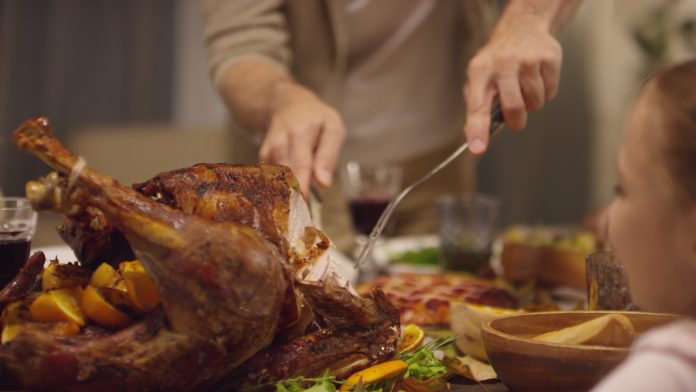“IS IT TRUE?” Thanksgiving Day November 28, 2024
IS IT TRUE that we wish all of our readers a Happy Thanksgiving weekend?
IS IT TRUE that we are thankful for another year of growth in internet traffic?
IS IT TRUE we are thankful that all of the members of the CCO staff and their families have survived another year? …that we are grateful for Ron’s progress since his fall early in the year?
IS IT TRUE that we are thankful for another sold-out Community Service Awards luncheon and we look forward to the 2025 awards?
IS IT TRUE that we are thankful for the advertisers who have stayed by our side and supported this homegrown, home owned publication?
IS IT TRUE that we are thankful that the city of Evansville has finished work on the bricks on Bob Jones Way?
IS IT TRUE we are thankful for the commitment made by Mayor Stephanie Terry to address the blight problem in the city? …that we will be thankful when the city addresses the industrial blight left by the Morton Avenue Warehouse and the recently burned mattress factory?
IS IT TRUE we wish only the best for our loyal readers in the coming year? And, Once again, have a Happy Thanksgiving!
Thanksgiving Dinner Cost Slightly Down in Indiana
Thanksgiving Dinner Cost Slightly Down in Indiana
Hoosiers gathering around the table for Thanksgiving dinner will find slight relief when it comes to purchasing ingredients, but the meal still reflects historically high costs. Indiana Farm Bureau’s annual Thanksgiving market basket survey shows that Hoosier shoppers can expect to spend approximately 2% less at the grocery store compared to 2023. According to this year’s pricing survey, Hoosiers are paying an average of $53.31 for a Thanksgiving dinner for 10 people, or $5.33 per person. Indiana’s market basket price also is approximately 8% lower, 48 cents less, than the U.S. average price of $58.08, or $5.81 per person.
The cost is still 25% higher than it was five years ago, which highlights the impact inflation has had on food prices since the pandemic. According to the U.S. Bureau of Labor Statistics, this is on par with the track of cumulative inflation for food at home, which has increased by 26%.
According to INFB Chief Economist Todd Davis, a main driver of the decrease in Indiana is the lower cost of the turkey, which is also less than the national average this year. Shoppers can expect to pay approximately $1.33 per pound for a whole turkey, or $21.22 for a 16-pound bird, which is about 17% less expensive than the national average of $25.67.
“Indiana ranks third in turkey production, with more than 8.4 million turkeys in the state, according to the latest U.S. Department of Agriculture’s (USDA) Census of Agriculture,” said Dr. Davis. “The turkey accounts for about 44% of the Thanksgiving dinner, so with Indiana in the heart of turkey production and with retail turkey prices down, it isn’t surprising that the turkey is more affordable this year, specifically in the Midwest. The concentration of turkey production in this region provides lower processing and marketing costs, which gets the turkey from the farm to the hands of the consumer efficiently.”
Another item that is less expensive this year is pumpkin pie filling. The cost for a 14-ounce package comes to $3.78, which is approximately 22% less than last year in Indiana. Pumpkin pie filling in Indiana is also about 9% less expensive than the 2024 U.S. average. Again, this can be attributed to Indiana’s proximity to pumpkin production, ranking second in pumpkin production in the country, according to USDA’s Census of Agriculture.
Half of the items in the market basket are less expensive for Hoosiers compared to last year, most notably pie shells and sweet potatoes. There are a few items that increased in price. The largest percentage price increase is for cranberries and whipping cream.
“Both of these products saw an increase in retail price, which is a product of supply and demand,” explained Dr. Davis. “Additionally, fluid milk production is down compared to last year, which correlates to an increase in prices for whipping cream and whole milk.”
Only sweet potatoes, cranberries and the veggie tray are more expensive in Indiana this year than they are nationally, with sweet potatoes about 18% more than the U.S. average. Dr. Davis noted that this could be a result of sweet potato production in the southern and western regions.
“Sweet potatoes also saw an increase in wholesale and retail prices nationally,” he continued. “Those retail prices can reflect transportation costs in moving goods from the farm to the grocery store. This highlights the collective impact of transportation costs, as well as labor, fuel and packaging, all of which are costs beyond the farm gate.”
According to the USDA, just 15.9 cents of every retail food dollar can be attributed to farm production, after accounting for input costs. Using this figure, the farmer’s share of this $53.31 market basket would be less than $8.50 The rest is for food processing, packaging, transportation, wholesale and retail distribution, and food service preparation.
“Growing the food families rely on for a Thanksgiving dinner can be a challenge for farmers because of input costs,” said Janis Highley, INFB 2nd vice president. “Just like consumers, farmers are price-takers, not price-makers, and the amount farmers are being paid doesn’t cover the increase of their input expenses.
“Nevertheless, Hoosier farmers find ways to streamline their operations and decrease costs of production. Many people don’t realize that Indiana is a top-producing state for turkey and pumpkins, so we have many local farmers to thank for our holiday meal this year. Turkeys also consume a significant amount of soybean and corn meal, top Hoosier farm commodities, so they’re important to our state’s economy too.”
The total market basket price of $53.31 includes a 16-pound turkey, stuffing, sweet potatoes, rolls, peas, a carrot and celery veggie tray, whole milk, cranberries, whipping cream, ingredients for pumpkin pie and miscellaneous baking items.
| Thanksgiving Market Basket Items (INFB Survey) | 2024 Indiana Costs | 2023 Indiana Costs | % Change of Indiana Costs (2023 to 2024) | % Difference between 2024 Indiana Costs and 2024 U.S. Average |
|---|---|---|---|---|
| Turkey (16 lb.) | $21.22 | $22.11 | -4.0% | -17.3% |
| Stuffing (14 oz. package) | $3.82 | $3.69 | 3.5% | -6.4% |
| Pumpkin pie filling mix (30 oz. can) | $3.78 | $4.82 | -21.6% | -8.9% |
| Pie shells, 9 in. (2 per package) | $3.37 | $2.89 | 16.6% | -0.9% |
| Sweet potatoes (3 lb.) | $3.47 | $4.02 | – 13.7% | +18.4% |
| Rolls (1 doz.) | $3.52 | $3.65 | -3.6% | -15.4% |
| Peas (16 oz. package, frozen) | $1.66 | $1.71 | -3.0% | -4.0% |
| Veggie tray (.5 lb. each fresh carrots and celery) | $0.96 | $0.93 | 3.2% | +14.3% |
| Whole milk (gal.) | $3.14 | $3.04 | 3.9% | -2.2% |
| Cranberries (fresh, 1 lb. package) | $2.74 | $2.26 | 21.2% | +16.6% |
| Whipping cream (½ pint) | $1.88 | $1.56 | 20.5% | 3.9% |
| Misc. ingredients (such as coffee, butter, onions, eggs, sugar and flour) |
$3.75 | $3.95 | – 5.1% | 0.0% |
| AVERAGE TOTAL MEAL PRICE* | $53.31 | $54.64 | -2.4% | -8.2% |
| *The total meal price listed above is for a group of 10 individuals. | ||||
The INFB Thanksgiving market basket survey is conducted in early November by volunteer shoppers across the state who collected prices on specific food items from one of their local grocery stores. Volunteer shoppers were asked to look for the best possible prices, without taking advantage of special promotional coupons or purchase deals. Indiana’s survey is completed in conjunction with a national survey administered by the American Farm Bureau Federation.
Surprising Facts You Never Knew About Thanksgiving
Surprising Facts You Never Knew About Thanksgiving
From the origin of T.V. dinners to the sounds that turkeys really make, there’s more to this holiday than meets the eye.
A woman named Sarah Josepha Hale lobbied Congress for years to make Thanksgiving an official holiday.
If it wasn’t for this determined woman, Thanksgiving wouldn’t exist today. Hale’s allegiance to Thanksgiving began in 1827 and was based in national pride; she hoped to make it permanently, an American custom and institution.†It wasn’t until 1863 that President Lincoln finally declared Thanksgiving a national holiday. Seeing as the President did this in throws of the Civil War, Thanksgiving is considered by some to be an attempt on behalf of the president to bring some peace back to the country.
Originally, Thanksgiving may not have been celebrated in November at all.
There isn’t clear historical information on the actual date of the first Thanksgiving, but some historians have suggested it may have taken place in mid-October. President Lincoln assigned the holiday to fall on the last Thursday in November, possibly to coincide with the date the Pilgrims first landed the Mayflower in New England.
In 1939, President Franklin D. Roosevelt moved Thanksgiving one week earlier.
Roosevelt hoped that a lengthened holiday shopping season would increase spending and alleviate the effects of the Great Depression. This resulted in two consecutive years of conflicting Thanksgiving Day celebrations, as some states refused to recognize the change.
By 1941, FDR gave in and signed a bill making the fourth Thursday in November the official date for Thanksgiving nationwide, regardless of whether it’s the last Thursday of the month or not.
The first Macy’s Thanksgiving Day Parade in 1924 featured animals from the Central Park Zoo.
Though the parade stretched just two blocks, New York City went all out for what newspapers called “a marathon of mirth.” Notably, however, there were none of the balloons the parade is known for today. Instead, there were live bears, elephants, camels, and monkeys from the Central Park Zoo. There were also floats with puppets, celebrities, bands, costumed Macy’s employees, and of course, Santa Claus.
Thanksgiving leftovers led to the first ever TV dinner.
In 1953, food corporation Swanson overestimated how much turkey would be consumed on Thanksgiving and had to get creative with 260 tons of leftover poultry. Using 5,000 aluminum trays and an assembly line of hand-packers, they created a Thanksgiving-inspired meal with the aforementioned turkey, cornbread dressing, gravy, peas, and sweet potatoes. The dish was sold for a grand total of 98 cents, and in the first full year of production, they sold ten million of them, birthing the prepackaged frozen meal industry.
Benjamin Franklin was very pro-turkey.
It wasn’t so much that Franklin thought the bird was delicious, but more so that he admired the animal’s qualities. Surprisingly, Franklin thought the turkey should be the United States’ official bird rather than the bald eagle.
“I wish the bald eagle had not been chosen as the representative of our country; his is a bird of bad moral character,” he once wrote. Apparently, Franklin noted that the turkey was a “much more respectable bird.
The menu for the first Thanksgiving in Plymouth in 1621 likely included lobster, seal, and swans.
No, turkey did not RSVP to the first Thanksgiving in 1621. The feast between Pilgrims and the Wampanoag Native Americans lasted for three days, during which both parties contributed to the meal. Though there are few records of the actual menu, it is known that the Pilgrims hunted for local fowl (swans included) and the Wampanoag brought five deer. It’s thought that lobster and seal were likely involved, due to their availability in the area.
Pumpkin pie has been beloved for a long, long time”although, it isn’t America’s favorite pie.
Records show that people have been cooking up pumpkin pies since the mid-1600s! Pumpkins were likely at the first Thanksgiving, although probably not in pie form. The dessert has been an important part of Thanksgiving meals since the 1700s”one Connecticut town even postponed the holiday in in 1705 due to a molasses shortage that prevented people from making pies. However, The American Pie Council is putting an end to the pumpkin vs. apple pie debate. According to their research, apple pies are America’s favorite, with pumpkin coming in second place.
Thanksgiving Day football games began in the 1870s.
Turkey Day football began long before the country could watch the sport on TV. In fact, football wasn’t even a professional sport when the Thanksgiving game tradition took hold. In 1876, Yale played Princeton in the first ever Thanksgiving Day football match. At that point, the sport was still evolving from a rugby hybrid into the game we know today. Games stayed on the college and high school level for nearly fifty years. Eventually, when the National Football League was founded in 1920, it began hosting as many as six Thanksgiving matches every year.
Female turkeys don’t gobble.
We humans gobble down dinner, and our feathered turkey friends just plain gobble, right? Not quite. Only male turkeys make the well-known “gobble, gobble” sound that has come to be associated with the holiday. In fact, male turkeys are even known as gobblers. Females make other noises, such as purring and cackling.
The day after Thanksgiving is especially busy for plumbers.
This sounds like the beginning of a crude joke, but it’s true. According, to plumbing company Roto-Rooter, the day after Thanksgiving is far and away the busiest day of the year. The company warns to be extra careful with turkey grease, potato peels, rice, and stuffing, as they are sure to clog your drain or overwork your garbage disposal.
With frigid temperatures forecasted, CenterPoint Energy provides important safety reminders and valuable tips to save energy while keeping warm
With frigid temperatures forecasted, CenterPoint Energy provides important safety reminders and valuable tips to save energy while keeping warm
Over the coming days, significantly colder temperatures are expected throughout Indiana with many areas of the state forecasted to experience temperatures in the low teens. CenterPoint Energy wants to remind customers it has a cold weather plan in place and is prepared for potential impacts from the colder weather ahead. This includes having crews stationed across the communities it serves and being ready to leverage fuel stored ahead of the winter heating season, if needed, to meet the anticipated increased customer demand for natural gas service. The company is also prepared to respond as safely and as quickly as possible to potential service issues.
Colder outdoor temperatures may require customers to use more energy to keep their homes at a comfortable temperature. CenterPoint is highlighting simple energy-saving and safety steps to help lower heating bills, while keeping customers safe and warm this winter.
Energy-saving Tips
Make sure your heating system is operating safely and efficiently.
An annual inspection and tune-up by a qualified technician are recommended. ·
Change or clean your furnace filter regularly. This helps maximize your furnace’s efficiency and life.
Turn down your thermostat. By lowering your thermostat by 7-10 degrees at night or when you’re away for at least eight hours, you can potentially save 10% on your heating costs.
With a programmable thermostat, you can have your heating system work around your schedule.
Keep warm air in and cold air out of your home. Use caulk or weather-stripping to seal leaks around doors, windows and other openings such as pipes or ducts. You can also roll up towels and push them against the bottom of the door’s interior to help prevent heat loss. Close fireplace dampers when not in use, so you don’t lose heat.
Use window coverings and blinds effectively. If it’s sunny outside, open your window coverings during the day to capture warmth from the sun, and close your coverings at night to keep warmth inside. If the sun’s not shining, keep your window coverings closed to hold warmth inside. ·
Circulate warm air with your ceiling fans.
Set your ceiling fans to turn clockwise slowly to move warm air from the ceiling to your living levels.
To learn more about these and other energy-saving tips, visit CenterPointEnergy.com/SavingsTips.
Safety Tips
Use space heaters safely. Make sure your space heater has an automatic shut-off, and keep children, pets and all items at least three feet away from it. A space heater that uses natural gas, propane or wood should be vented to the outside. Stoves and ovens should never be used for space heating.
Test your carbon monoxide (CO) and smoke alarms to make sure they work properly. Change batteries regularly. Alarms don’t last forever, so replace them according to the manufacturer’s instructions.
Know the signs of CO poisoning. Early symptoms such as headache and fatigue are similar to the flu, but without a fever. Continued CO exposure can lead to more severe headaches, dizziness, nausea, difficulty thinking clearly and fainting. If everyone in a household is experiencing these symptoms, it could be CO poisoning. If you suspect you could have CO poisoning, leave the area immediately, get fresh air and call 911.
Immediately report a suspected natural gas leak. If you smell the “rotten egg” odor of natural gas, immediately leave on foot, go to a safe location and call both 911 and CenterPoint Energy at 800-296-9815. Don’t use electric switches and outlets, phones (including cell phones), drive or start a car inside or close to the location or do anything that could cause a spark.
Free Thanksgiving Lunch Today at Sauced
An Evansville restaurant is once again inviting community members to a free lunch buffet this Thanksgiving. Sauced will be hosting the free buffet in its ballroom from 11 a.m. to 2 p.m. Thursday. Anyone is welcome to attend the event at Sauced, which is located at 1113 Parrett St. in Evansville. The event is happening in Sauced’s Ballroom. A cash bar will be available.
EPD DAILY ACTIVITY REPORT
FOOTNOTE: EPD DAILY ACTIVITY REPORT information was provided by the EPD and posted by the City-County-County Observer without opinion, bias, or editing.











